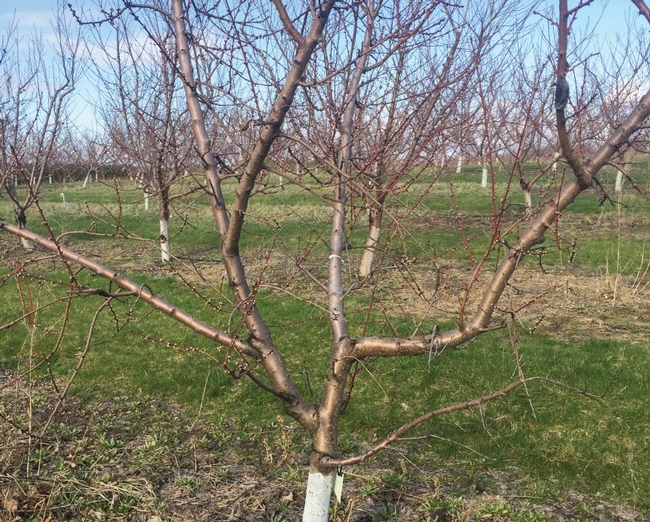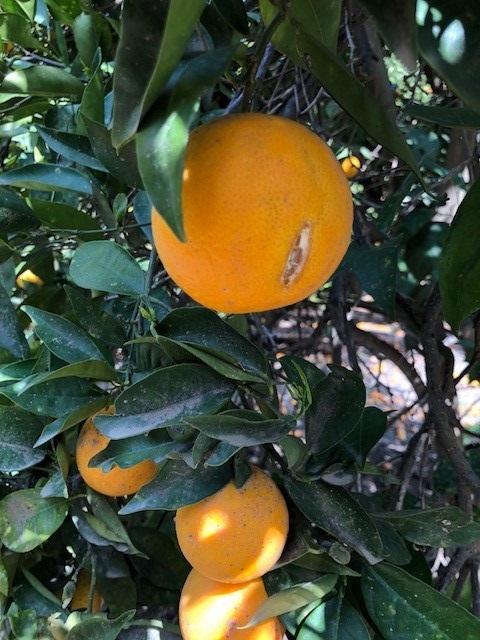
Posts Tagged: deciduous fruit
What Winter? Not Cold Enough for Apricot, Too Warm for Valencia
So, there are peach trees right now that are flower-less and leaf-less. Wisteria which should have flowered in February is bare. The Royal apricot next door has no flower. The Lombardy poplars and birch in Oxnard don't have leaves. Spring is here, grass is growing, but many deciduous trees are still leafless and haven't flowered? What is going on?
Deciduous fruit trees and many landscape trees like poplar, birch, willow and sycamore, etc. must go through a dormant period each winter in preparation for producing fruit and leaves the following spring and summer. This rest period, also known as a chilling period, is directly related to winter temperatures. For many varieties of trees, the most efficient temperature for chilling is 45°F, with little additional chilling effect at temperatures below 32°F. Brief warm spells in winter have a negative effect — temperatures above 70°F for four or more hours offset any chilling that happened in the previous 24-36 hours.
Once chilling is complete, the trees prepare to wake up from dormancy and bud after a certain amount of warming takes place. The amount of required warming is cumulative, measured by counting the number of degrees each day above a threshold temperature, usually 40°F. This cumulative warming, combined with how well the tree met its chilling requirement over the winter, determines whether a tree buds early or late in the spring.
Tables and charts have been developed for different chilling requirements of fruit trees. The number of hours needed at or below 45°F varies with the type of tree:
- Peach: 400 to 1050 hours
- Apple: 800 to 1100 hours
- Cherry: 1000+ hours
But in coastal Southern California, those hours are never achieved. You need to go to Santa Ynez to get close to those hours. More typically in the Santa Paula, Santa Barbara, San Luis Obispo area, the chilling hours below 45 are close to 200 and lower in many years. Some years there is more, some years less. How temperatures above 70 affect chilling aren't always clear. As a result there are several different ways to account for chilling and none of them work very well for the coast./
Fortunately, we have low-chill varieties of many fruit trees that will produce with lower chilling. So ‘Anna' apple and ‘Royal' apricot do well, and many landscape trees are adapted to the lower winter chilling along the coast and do well. Low chill blueberries thrive to the point that in many years, they don't even go dormant.
This year the warm, cold, warm, cold pattern has mixed trees up. There are some deciduous trees that are doing fine, while others still have not flowered and leafed out. The mix of temperatures is not following the traditional patterns used to calculate chilling requirement. The trees are following their own pattern.
In the last several years in Southern California, winters have seemed shorter and milder, resulting in earlier springs. Trees that have flourished in a location could have decreasing yields in the future, and the favorable locations to grow these fruit trees could shift.
The Fruit and Nut Center at UC Davis has a link to the CIMIS system operated by the CA Dept of Water Resources. The site has various methods of calculating chilling hours, none of them seem adequate though for describing what is happening in the landscape today in Southern California
http://fruitsandnuts.ucdavis.edu/Weather_Services/chilling_accumulation_models/
Look at it to see if you can see a new way of understanding deciduous tree response to the weather.
Just got a call recently that 'Valencia' oranges are splitting. This normally happens to ripe 'Navels' that are over mature and get erratic winter irrigation, especially during drought. In this case, the 'Valencias' are advanced in maturity because of the warm winter, probably advanced by two months. Again erratic watering has probably lead to this splitting.
What a crazy winter.
Splitting coastal 'Valencia' oranges in April, 2018
photo: Peaches without adequate chilling.

no chill peach
Fruit and Nut Trees for Coastal California
It's possible to grown many other tree crops along the coast other than avocado and citrus. When speaking of other perennial evergreens like avocado, trees that don't lose their leaves but retain a canopy year round, we want trees that can handle the occasional cold periods that happen in winter. In fact, some trees like 'Hass' avocado need something like 50 hours of chilling – hours below 45 degree Fahrenheit. When trying to grow ‘Hass' in the tropics, the tree gradually loses vigor because the cold need to break dormancy of buds isn't there. So they grow tropical varieties in Florida and the Dominican Republic and consumers get used to the less oily flavor of the tropical varieties. Low or no chilling requirement fruit trees like durian, jackfruit and other tropical fruit can't handle the cold we get in coastal California. There are many different unusual fruits that can be grown, like cherimoya, sapote and mango throughout the southland.
However, if we try to grow low chill varieties of deciduous fruit that can handle winter cold, like apple and peach varieties, they often have insipid in flavor. Here's a list of fruit trees that are adapted to coastal southern California. And if you choose any of the deciduous varieties, make sure you plant them bare root next winter. They are cheaper and transplant better with less transplant shock than planting them when they are in leaf.
http://ceventura.ucanr.edu/Com_Ag/Subtropical/Fruit_and_Nut_Varieties/

peaches
Why is my Apple, Walnut, Blueberry, Peach, etc. Not Flowering and Looking Terrible?
Deciduous plants need a certain period of dormancy during which they accumulate hours of cold. This is a very practical process on their part, since most dormant plants grow in cold climates. Differing areas have different patterns of cold. Some areas have very distinct ending points to the winter and if the plant leafs out, it will grow and be fine. In many winter areas, the end point is not distinct. Spring may come on with glorious weather, but then there might a cold snap in the spring and all that new growth is frozen back. Plants that have survived in these spring frost areas will thrive. Those that have not adapted to the erratic spring weather will die.
Chilling hours are the number of hours needed to take the plant into a period where it is assured of not getting hit by the cold. The are different ways of calculating this and the plant has an internal mechanism that has developed in that area to make sure it comes into a period where there is less likely-hood of a late freeze occurring.
So what has happened is that humans have moved plants around and moved them out of the areas where they are best adapted. It looks better, tastes better, has the characteristics that people want. So we move plants that require a lot chilling into areas that don't have much cold weather. And we move plants that require low chilling into areas that have cold winters. In the latter case, one knows right away that a mistake has been made because the plant flowers too early and gets hit by the late spring cold.
In the former case where plants requiring high chill are moved into warmer winter areas some odd things happen. For example the plant never leafs out in the spring. Then one knows there is not enough cold in that area to grow the plant successfully. Delayed flowering and leaf out are the most common for plants growing in marginally cold areas. This may not be noticeable in most winters when a normal winter occurs.
But this winter has been different in California. It was way too warm. And in many areas fruit trees requiring more chill than happened, just have not flowered or leafed out. Areas along the coast has been the worst hit, but it has happened in the Sierra foothills and the San Joaquin Valley. These were trees that were out of place and it is sad to see. The only thing that can be done at this point is hope for colder weather next year. But maybe that is not something one should hope for too much.
Effects on lack of adequate chilling on apricot - delayed and uneven bloom.

low chill apricot

